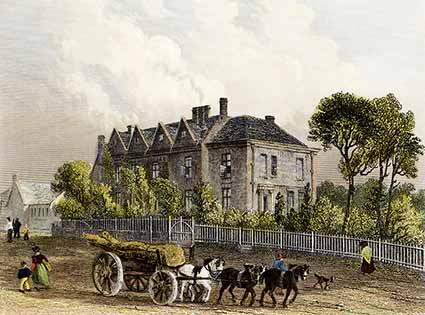Queen’s House

At the top of the High Street, Queen’s House is a familiar, imposing sight to people entering the village by this route. The principal building owned by the Crown in the New Forest, it is the local headquarters of the Forestry Commission, and also has attached the Verderers’ Hall, home of the ancient Verderers' Court.
And what a history has this house. Essentially, it is characteristic of a 17th century mansion, and is the only surviving major building of the Charles I period in the whole of Hampshire.
But the first record of a building on this site is way before Charles’s time. In fact, it is in 1297, in the reign of Edward I. Then order was made for ‘twenty oaks to make laths for the use of the Queen’s manor house at Lyndhurst.’
The Queen in question: Eleanor of Castile, Edward’s first queen, who made Lyndhurst her home when the king was away fighting the Welsh - Edward completed the conquest of Wales in devastating campaigns of 1276-77 and 1282-83, and built huge castles to keep it secure. He also subdued Scotland, albeit temporarily.
Edward’s second queen, Margaret of France, nicknamed ‘the Pearl of France’, held the Manor of Lyndhurst from 1299 to 1318; Queen Isabel, widow of Edward II, held it from 1318 to 1330; and Philippa, the Queen of Edward III, had it from 1330 to 1332. It’s likely, of course, that all stayed at the royal manor house.
Rebuilding took place in the reign of Henry VIII, and, more substantially, between 1634 and 1672 in the reigns of Charles I and his son, Charles II – the work was interrupted by the English Civil War. Bricks for this later re-building were made at Clayhill, on the outskirts of Lyndhurst.
Charles I hunted from Lyndhurst, and, probably, so too did the second Charles and also James II. The last sovereign to stay at the house, though, was George III for a short period in 1789. Richardson, King and Driver on their map of the same year show in this location the King’s House, for the name changes with the gender of the monarch.
The tenancy was held by royal dukes from 1771 until 1850 - the last royal resident was His Royal Highness Adolphus, Duke of Cambridge, seventh son of George III, who lived in the house from 1827 to 1849.
On the death of Adolphus, Queen’s House became the New Forest, Deputy Surveyor’s official residence, and then from 1915 until 1961, the living quarters were let privately. In 1966/67 the house was adapted to provide Forestry Commission office accommodation.
Visible from the roadside, cast in lead on the rain-heads, are dates and the initials of the monarchs in whose reign the building was extended or repaired: AR 1712 (Queen Anne), VR 1880 (Queen Victoria) and, on the side of the Verderers’ Hall, ER 1904 (Edward VII).
Out of public sight are also GR III 1748 (George III) and E11R 1983 (the current Queen).
Oddly, the dates are not considered to be a reliable guide to the actual dates of repair or restoration.
References:
The Queen’s House, Lyndhurst: Forestry Commission Guide
Lyndhurst Historical Society publications: Roy Jackman
Lyndhurst – A Brief History and Guide: Georgina Babey and Peter Roberts
More links
Other related links
Search this site

Sadly, 58 animals were killed - 35 ponies, 13 cows, 8 donkeys and 2 sheep, whilst a further 32 were injured - 3 pigs, 9 donkeys, 11 cows and 9 ponies.
(Forty-three accidents occurred in daylight, 15 at twilight and 101 in the dark. Twenty-seven accidents were not reported by the driver involved).
Here's just one horrific example - Three donkeys killed in collision with van at notorious New Forest blackspot (Advertiser and Times)

